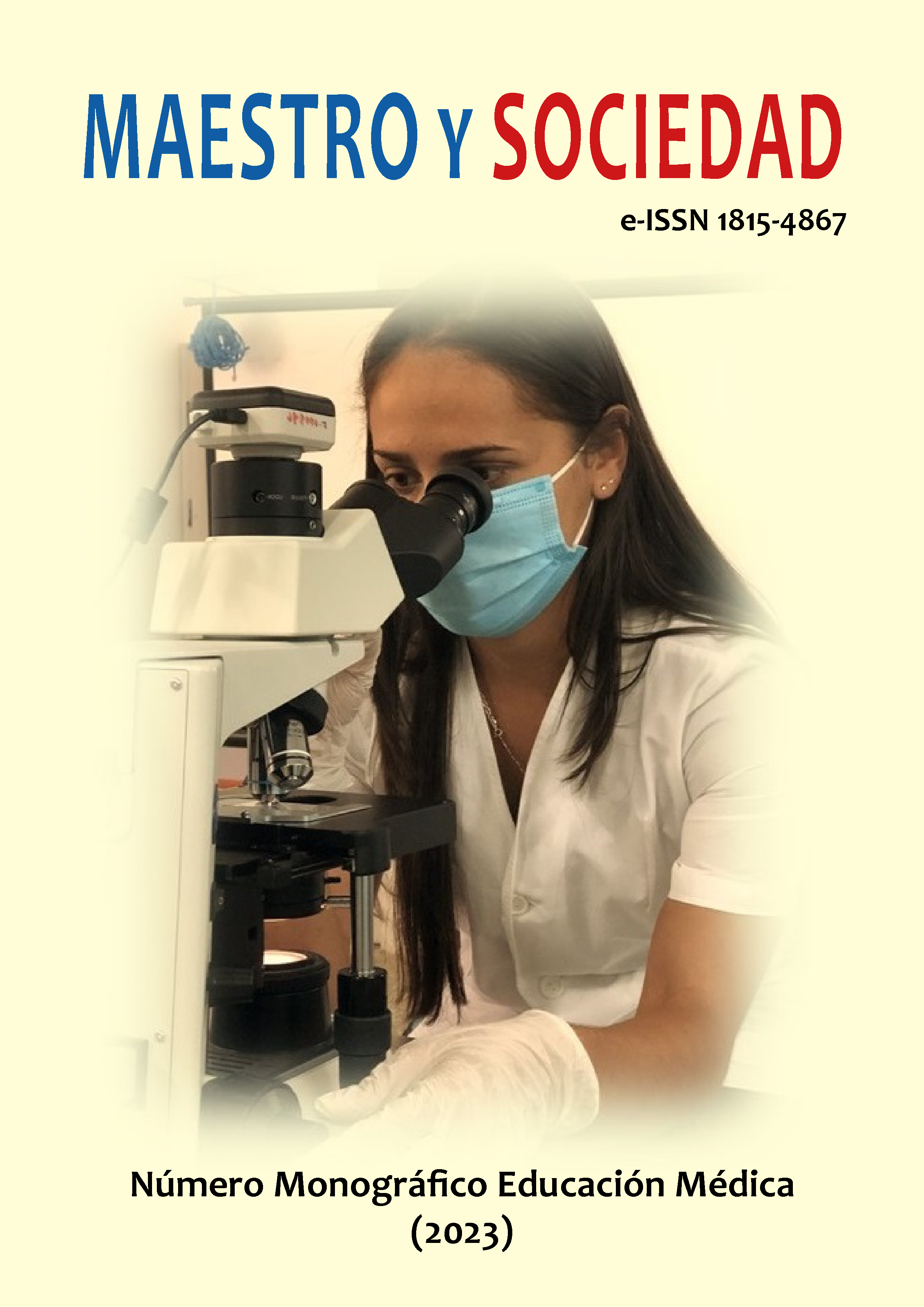Teaching guides for independent work in the Nervous, Endocrine and Reproductive System subject
Teaching guides for independent work in the Nervous, Endocrine and Reproductive System subject
Keywords:
didactic guide, teaching-learning process, independent workAbstract
Introduction: The medical university demands a teaching-learning process where students acquire autonomy and
cognitive independence. In this sense, the didactic guide becomes a basic resource with great meaning and functionality
since it guides the student how to carry out independent work, which became relevant in times of Covid -19. Objective:
To evaluate the usefulness of the didactic guides for the orientation of independent work to favor the systematization of
the essentials of the content in the Nervous, Endocrine and Reproductive System subject that contributes to adequate
professional performance. Materials and Methods: Methods such as: analysis-synthesis, induction-deduction and
documentary review and survey in the form of a student questionnaire were used. Results: The students appropriated in
a logical and orderly way all the necessary knowledge to understand the functioning of the endocrine system from the
morphofunctional point of view, establishing an interrelationship between the subjects. Discussion: García Hernández
et al. (2014) state that the didactic guide conceptually distinguishes the guiding nature of teaching in relation to mental
development, considering learning as a source of that progress. By taking learning styles into account, it allows them to be developed on the basis of knowledge of the weaknesses and strengths of each student through the language
of teaching tasks, favoring their comprehensive training. Conclusions: The use of the didactic guides in the Nervous,
Endocrine and Reproductive System subject was valued as positive when directing students in the self-management of
knowledge; contributing to significant, creative learning and the strengthening of moral values.
References
Boyezuk, D. A., Muro, M. G., Trigo, M. S., Arias, R. O., & Cordiviola, C. A. (2019). Coautoría colectiva: analizando una
práctica áulica en el espacio universitario. Trayectorias Universitarias, 5(9), e015, https://doi.org/10.24215/24690090e015.
Campos, I. M. (2020). Experiencias del trabajo metodológico para la dirección del proceso de enseñanzaaprendizaje
de la clase encuentro. Revista de Educación & Pensamiento, 25(27), 26-35.
García Hernández, I., de la Cruz Blanco, G. M. (2014). Las guías didácticas: recursos necesarios para el aprendizaje autónomo. EDUMECENTRO, 6(3). http://scielo.sld.cu/scielo.php?script=sci_arttext&pid=S2077-
&lng=es.
García, I., & de la Cruz, G. (2014). Las guías didácticas: recursos necesarios para el aprendizaje autónomo.
Edumecentro, 6(3), 162-175. http://scielo.sld.cu/pdf/edu/v6n3/edu12314.pdf.
González Jaramillo, S., Recino Pineda, U. (2013). Las estrategias de aprendizaje en la Educación Médica Superior.
EDUMECENTRO, 5(3). http://scielo.sld.cu/scielo.php?script=sci_arttext&pid=S2077-28742013000300015
Hernández Infante, R. C. (2016). El método de enseñanza-aprendizaje de trabajo independiente en la clase
encuentro: recomendaciones didácticas. Revista de Pedagogía, 37(101), 215-231.
López Romero, M. A., Crisol Moya, E. (2012). Las guías de aprendizaje autónomo como herramienta didáctica de
apoyo a la docencia. Escuela Abierta. Rev de Invest Educ., (15), 9-31.
Ministerio de Educación Superior. (2022). Resolución No. 47/22. Reglamento Organizativo del Proceso Docente
y de Dirección del Trabajo Docente y Metodológico para las carreras universitarias.
Ministerio de Salud Pública. (2018). Programa de la disciplina Bases Biológicas de la Medicina. Universidad de
Ciencias Médicas de La Habana.
Ministerio de Salud Pública. (2019). Plan de estudios E. Universidad de Ciencias Médicas de La Habana. Centro
Rector para planes y programas de estudios en Salud.
Murcia Herrera, A. (2016). Diseño de guías didácticas para la enseñanza aprendizaje de la Morfología Humana
estudiantes de citohistotecnología primer semestre Fundación Universitaria de Ciencias de la Salud –FUCS. [Trabajo de
grado. Colombia].
Pantoja Castro, J. C., Covarrubias Papahiu, P. (2013). La enseñanza de la biología en el bachillerato a partir
del aprendizaje basado en problemas (ABP). Perfiles Educativos, 35(139). http://www.redalyc.org/articulo.
oa?id=13225611005
Pino, R., & Urías, G. (2020). Guías didácticas en el proceso enseñanza-aprendizaje: ¿Nueva estrategia? Revista
Scientific, 5(18), 371-392. https://doi.org/10.29394/Scientific.issn.2542-2987.2020.5.18.20.371-392
Rondón Carrasco, J. y Morales Vázquez, C. L. (2021). Confección de una guía didáctica para el estudio de la
atención prenatal. Revista Observatorio de las Ciencias Sociales en Iberoamérica, 2(16), 100-113. https://www.eumed.
net/es/revistas/observatorio-de-las-ciencias-sociales-en-iberoamerica/ocsi-nov-2021/guia-didactica
Soca Guevara, E. B. (2015). El trabajo independiente en el proceso de enseñanza-aprendizaje. RCIM, 7(2).
Unesco. (2019). https://es.unesco.org/themes/educacion-superior/ods.
Zabalza, M. (2002). La enseñanza universitaria. El escenario y sus protagonistas. Narcea.
Published
How to Cite
Issue
Section
License
Copyright (c) 2023 Lianne Alicia Chang Arañó, Yenifer Encarnación Cobián Artimes, Dalgis Léon Duharte, Yarlin Rodríguez Rabell

This work is licensed under a Creative Commons Attribution-NonCommercial-NoDerivatives 4.0 International License.
This journal provides immediate open access to its content, based on the principle that offering the public free access to research helps a greater global exchange of knowledge. Each author is responsible for the content of each of their articles.



























 Universidad de Oriente
Universidad de Oriente 